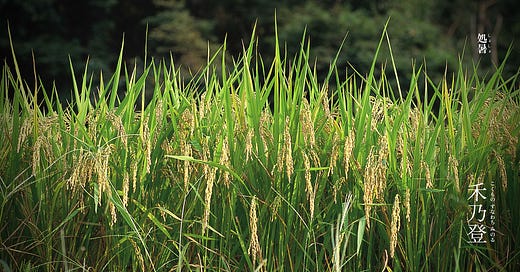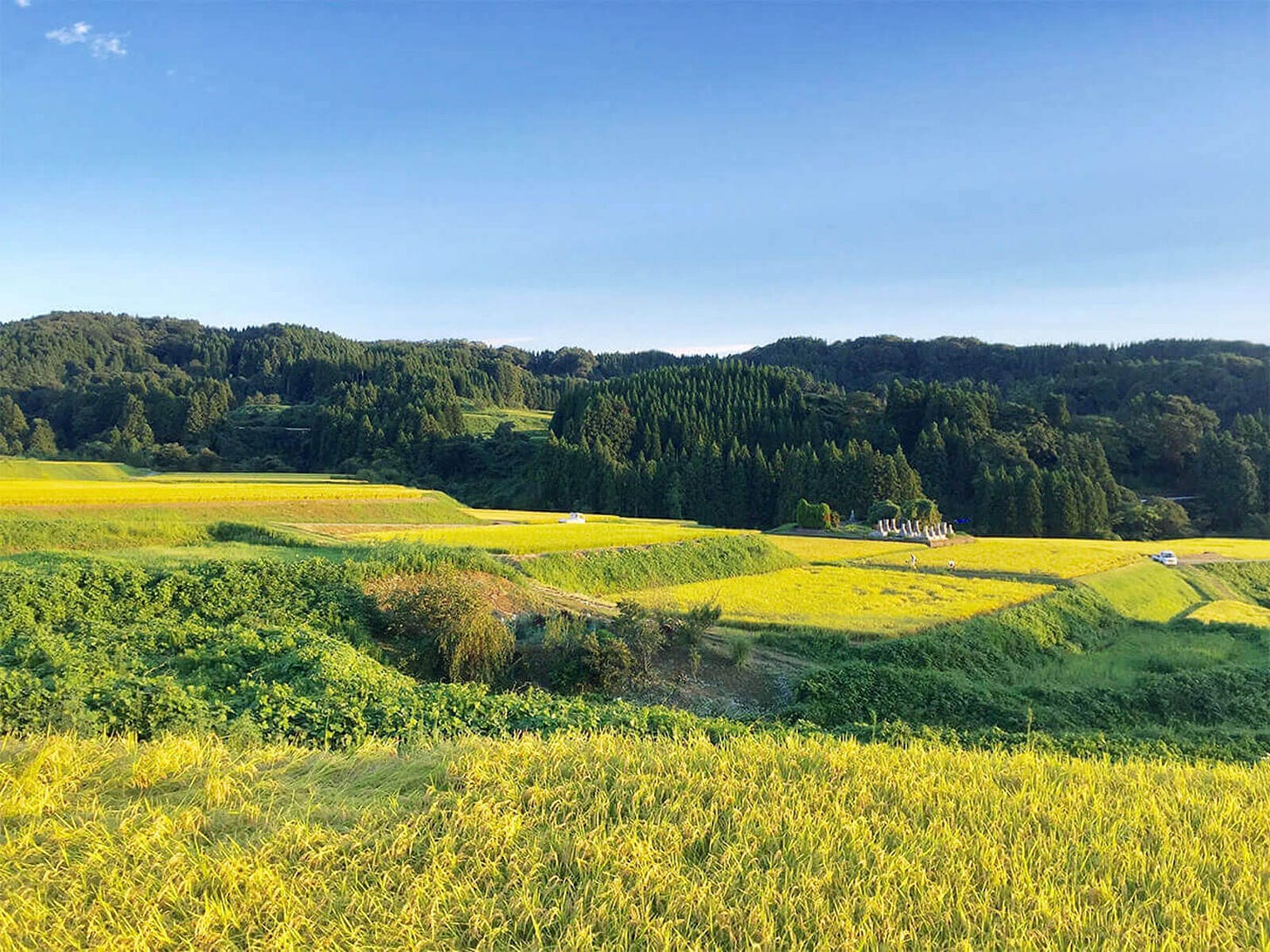September 3 - 7
禾乃登
こくもの すなわち みのる
Kokumono sunawachi minoru
”Grain fields turn gold”
It is hard to imagine, in a post-scarcity society, the relief of seeing a successful harvest. How before the advancement of common knowledge and technology, before global supply chains and stockpiled resources that ensured food was readily available year-round, a field of healthy grains would have looked as beautiful as actual gold.
The kanji character 禾, read either as ine or nogi, is often translated as “rice,”1 but broadly covers all the various grains that Japan grows (which we covered in more detail back in Kō 24). Indeed, the kokumono (穀物) part given to this kō’s Japanese name directly means “cereal grains.” But whereas June’s Kō 24 was mainly concerned with barley, this one is in fact mainly concerned with rice.2
We’ve covered rice before, and will likely do so again given its prominence in Japanese culture and cuisine, but now’s as good a time as any to talk about the many things it can become. That is: what happens after the harvest.
With an abundance of precaution given the remaining possibility of damaging typhoons in this season, rice harvests will begin up and down the country at farms ranging from massive commercial enterprises to backyard plots3. In many towns—particularly those where rice-growing is a key part of its history or culture—this is kicked off with a type of harvest festival called a Fū-chinsai (風鎮祭, “wind ceremony”) or Fūjo-matsuri (風除祭 “wind-parting festival”). These festivals are performed with the intent to appeal to the gods of wind (the 風 part of the names)4 in hopes they’ll ease off on the destructive gales for a bit.
During the day, prayers and offerings will be made to the local gods associated with winds and storms. The offerings will be one used in many Shintō religious ceremonies: nihonshū, or rice wine. For Fū-chinsai, this will be made from the first harvest, giving the gods their due before taking for any earthly uses. The evenings will see a variety of celebrations and cultural rituals unique to the area, but they’ll often include parades of religious floats or portable shrines, as well as traditional dances with movements that represent the harvest or interpretations of the town’s prayers.
(Above: scenes from this year’s Owara-Kaze-no-Bon festival in Toyama City, which is one of the country’s most famous wind ceremonies)
When the winds have safely passed and turned gentle, and the celebrations of bountiful golden fields have wrapped up, the actual hard work of harvesting begins. For most local community farmers, this work is carried out with family, friends, and neighbors and the help of some rented machinery. The year’s harvest is then usually taken to a nearby JA (Japan Agriculture) branch, which is the dominant national farming co-op organization. The JA then collects the region’s rice haul and distributes it via their large wholesale connections, where it’s either sold to be eaten or made into various food and drink. That’s the basics, anyway.5
Of course, you don’t have to sell everything you grow. Plenty of farmers keep a good stock for personal use, and can do their own milling without the JA at a handy coin-operated milling booth6, which are a common sight even in pretty urban areas. Here’s a handy instructional video, should you ever find yourself with a few kilos of unpolished brown rice:
And even though I’ve used this segue before, what better to go with freshly milled white rice than some seasonal items?
● Seasonal fruit
ichijiku, 無花果, figs● Seasonal seafood
iwashi, 鰯, sardine7● Seasonal plant
enokorogusa, 狗尾草, green foxtail



Every step of growing something is important: preparing the field, planting, caring, watching, and finally harvesting. And there are various gods to supplicate and practical steps to follow all along the way. It’s a huge amount of time and effort dedicated to something so small, but when something’s important you put in the work. Or maybe it’s made important by the work we invest in it, and the presence it gains in our daily lives as a result.
One stalk of rice yields less than 100 grains of rice, and a bowl of rice can hold 10,000. But each one of those grains came from a carefully tended seed, sitting under the sun in a flooded field somewhere. For the many Japanese people who enjoy a bowl or three every day, the prayers and parades are probably worth it. If nothing else, to make sure we’re paying due respect to the plant itself. A bit of gold grown by our own hands.
See you next kō~
[Images & info by kurashikata.com, kurashi-no-hotorisya.jp, 543life.com, and Wikipedia except where otherwise noted]
If you want to be specific, you can use the character 稲, also read ine but only means rice
I chose to go with "grains" for my translation of the name simply because I like alliteration—looking back I could have gone with “Rice Rears Richly”
Many of these small, individually-owned plots are a result of government redistribution of land purchased post-War in an effort to revitalize the nation’s agricultural output
In fact, in most places the events are shortened to just 風祭り, which takes on a kunyomi Japanese reading to be pronounced kaza-matsuri
For anyone really interested in the nitty-gritty of this arrangement, there’s a great writeup here
Provided you want hakumai (白米, white rice) instead of unmilled genmai (玄米, brown rice)
Specifically of the Japanese pilchard







The rice processing video is really cool! Thank you for reminding me how there is so much beauty in the ordinary tasks of daily life. The everyday things we take for granted today would have seemed fantastical just a few generations ago.